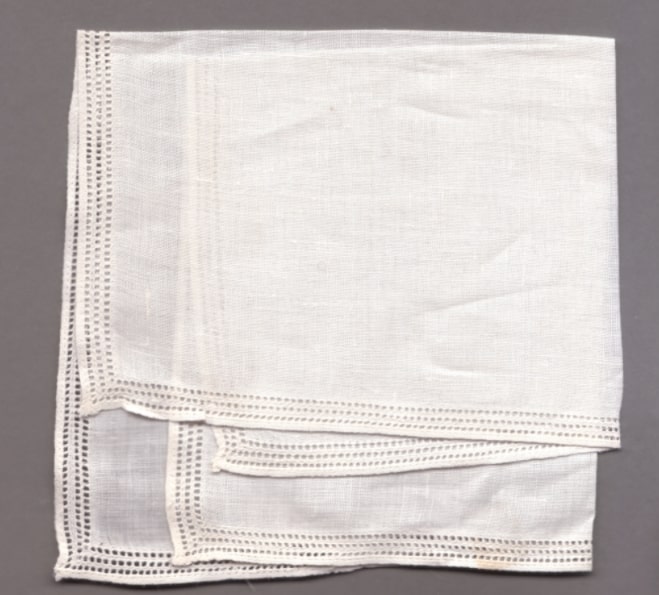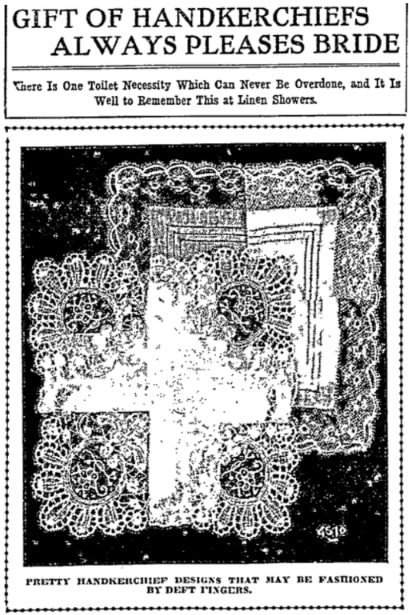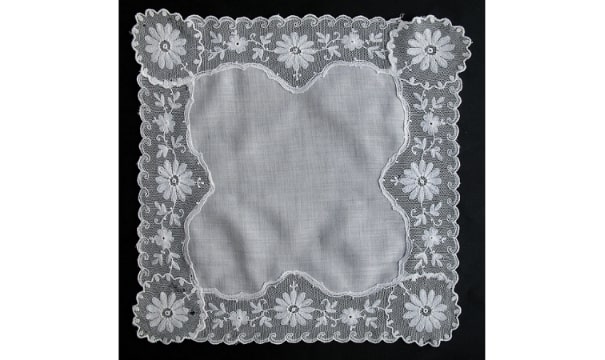Introduction: In this article, Gena Philibert-Ortega writes about something that was a big part of our ancestors’ lives, but not so much today: the handkerchief. Gena is a genealogist and author of the book “From the Family Kitchen.”
I distinctly remember the first time I learned about women’s handkerchiefs. I was around 11 years old shopping at an antique store with my parents and an aunt (my mother’s sister). My aunt walked up to a booth and purchased a decorative hankie from a bygone era. She then explained that she preferred them to paper tissues.
I remember being fascinated by the basket of hankies in that antique booth that ranged from the highly embellished with tatted edges or embroidery designs, to the colorful, and the plain white. But I also wondered why someone would use them – and why we didn’t anymore.

Having recently talked with some quilters about quilts made with vintage hankies, I decided to take a look at historical newspapers to learn a little more about their original popularity and why they fell out of favor.
Handkerchiefs in Historical Newspapers
Handkerchiefs have a long history, but if we fast forward to the early 20th century, handkerchiefs were a popular gift and part of every man and woman’s must-haves. There’s no doubt that handkerchiefs were part of everyday life. I found newspaper articles about “handkerchief showers” for brides-to-be and handkerchief “events” which were big sales at local retailers.

They were so popular that at some point, people had too many handkerchiefs. Newspaper articles shared ideas for creative ways to reuse them. This 1915 newspaper article suggested that those extra handkerchiefs could be used to make a bureau scarf, a baby cap, or a party favor.
This next newspaper article claimed that a new 1928 fad transformed the handkerchief into a “trinket of fashion” by tying it to your wrist so that it would flutter as you dance.
Newspaper articles about handkerchiefs, buying them, gifting them, and reinventing them were commonplace. They were the must-have accessory. So, what happened?
Sanitary Handkerchiefs
Concerns for public health and the problems that handkerchiefs caused, as something that would become wet and filled with germs, started to be addressed. Newspaper articles about providing children with sanitary handkerchiefs started appearing in newspapers in the 20th century, like this one from Dallas in 1912 reporting that Dr. Horace B. Blan found that handkerchiefs were the cause of infectious diseases. The article discussed Dr. Blan and his study, which found that the majority of used handkerchiefs were filled with germs, including tubercular bacteria.
Although handkerchiefs were identified as a cause of spreading illness, they were also seen as a tool to stop the spread of germs. Early 20th century concerns included spitting and uncovered coughs. Handkerchiefs were identified as something to use to cover a cough. This especially became a concern during the 1918 influenza pandemic.
Newspaper articles addressed unsanitary handkerchiefs and other linens by discussing way to best launder them in a “sanitary” way. This 1922 example explained that the way to wash laundry had changed and that washing everything together was not sanitary. Items should be separated and washed in groups so that a tablecloth wasn’t washed with undergarments, for example.
World War I helped to bring attention to a paper product that led to a new type of disposable handkerchief. During World War I, nurses noticed that a crepe paper gas mask filter was also good for use as a menstrual pad. By 1924, the Kimberly Clark company suggested an additional use for their paper product: to remove cold cream. By the 1930s, the paper handkerchief had gone from a sanitary way to remove cold cream to a disposal handkerchief for colds.*
Marketing focused on fabric handkerchiefs being “damp, disgusting” and promoted “soft, dry Kleenex disposable tissues” as more sanitary, and also cheaper than laundering handkerchiefs.
History Tip: Why did women need a special product to help take off cold cream? Cold cream is a face cleanser and moisturizer made from water, oil, and wax. This thick cream is best removed with a washcloth or tissue paper and not with water like other cleansers.
The End of an Era
In the end, smart marketing and public health concerns marked the demise of the cloth handkerchief for the most part. Today handkerchiefs are mostly seen as an accessory to men’s suits, but they are no longer the must-have for everyone. Times change and concerns about health led to innovative uses for existing products.
* “Kleenex Brand Story,” Kleenex (https://www.kleenex.com/en-us/about-us/our-history#:~:text=1924,product%20%2D%20%E2%80%9Cabsorbent%20kerchiefs.%E2%80%9D: accessed 18 October 2023).
Explore over 330 years of newspapers and historical records in GenealogyBank. Discover your family story! Start a 7-Day Free Trial
Note on the header image: lace handkerchief. Credit: Goldi64; Wikimedia Commons.
